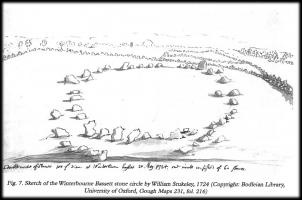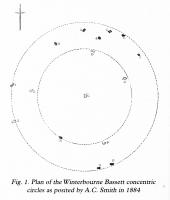Text this colour links to Pages. Text this colour links to Family Trees. Text this colour are links that are disabled for Guests.
Place the mouse over images to see a larger image. Click on paintings to see the painter's Biography Page. Mouse over links for a preview. Move the mouse off the painting or link to close the popup.
Winterbourne Basset Stone Circle is in Winterbourne Basset, Wiltshire [Map], Avebury Stone Circles.
Avebury by William Stukeley. If we descend the Hakpen-hill [Map], westward from hence towards Winterburn-basset, upon the declivity of the Hakpen, is another Druid's house, called too Old Chapel. 'Tis a square, double ditched, but small ditches, in the middle a broad oblong square bank. Before it a sort of court, nearly as big as the other. Near it, they say, they have found much old iron and pewter. It seems to have been set round with stones [Winterbourne Basset Stone Circle [Map]].
Avebury by William Stukeley. At Winterburn-basset, a little north of Abury, in a field north-west of the church, upon elevated ground, is a double circle of stones concentric, 60 cubits diameter. The two circles [Winterbourne Basset Stone Circle [Map]] are near one another, so that one may walk between. Many of the stones have of late been carryed away. West of it is a single, broad, flat, and high stone, standing by itself. And about as far northward from the circle, in a ploughed field, is a barrow set round with, or rather composed of large stones. I take this double circle to have been a family-chapel, as we may call it, to an archdruid dwelling near thereabouts, whilst Abury was his cathedral.

1724. An unpublished pen and ink wash sketch of Winterbourne Basset Stone Circle [Map] by Stukeley, archived amongst the Gough Maps at the Bodleian Library, Oxford (Gough Maps 231 Fol 216).
Wiltshire Archaeological Magazine 1857 V4 Pages 307-363. "At Winterbourne Basset, (about three miles) north of Abury, a field north west of the church, upon elevated ground, is a double circle of stones [Winterbourne Basset Stone Circle [Map]], concentric, 60 cubits diameter. The two circles are near one another, so that one may walk between. Many of the stones have of late been carried away. West of it is a single, broad, flat, and high stone, standing by itself; and about as far northward from the circle, in a ploughed field, is a barrow set round with, or rather composed of large stones."1 "By the above description, I was enabled," says Sir R. Hoare, "to find the remains of this circle, which is situated in a pasture ground at the angle of a road leading to Broad Hinton, and consists at present only of a few inconsiderable stones."2
Note 1. Stukeley's Abury, p. 45.
Note 2. Hoare's Ancient Wiltshire, ii. p. 95.

Winterbourne Basset Stone Circle [Map]. 1884 plan by A C Smith.